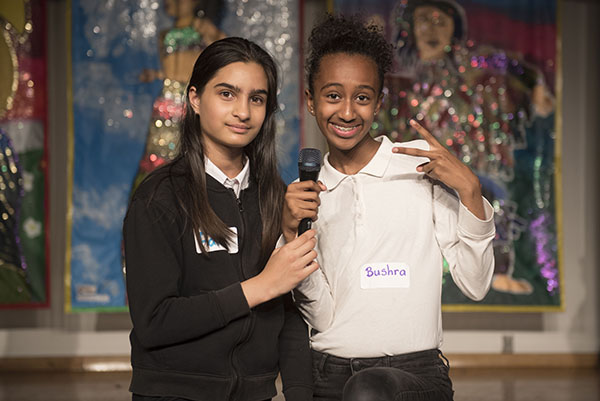What did the students say about V.I.B.E?
Grade 8 student Navin Estrano: “This was a chance for me to speak up. I got to learn more about my history. I knew about my Spanish part, because that’s what I always talked about with my family. Through this, I got to see my other side.”
Grade 7 student Bushra Kahsai: “I participated in V.I.B.E. because I felt like people underestimated Black people. If you went to the Black is Beautiful session, they were talking about Eurocentric standards and Afrocentric standards—they really are different.”
Grade 7 student Falak Shah: “Even if someone tries to put you down and if someone tries to talk to you very badly and tries to demotivate you that you don’t need to listen to them and you know what you’re worth. Don’t try to explain to them using your actions, use your words to fight against them.”

The students rose in the gymnasium of Amesbury Middle School for the singing of the Black National Anthem. That’s how the day started at the school’s V.I.B.E. (Voices in Black Excellence) conference
“We need to be our own voice”
Students from Amesbury, Brookhaven Public School and Gracefield Public School participated in the conference that centred the voices of Black students.
“I joined V.I.B.E. because I like standing up for children’s voices,” says Caydee Lewis, a Grade 6 student at Amesbury. “We’re always told that you have to listen to the adult, the adult is always right and I don’t like that. We also have a voice. If we get told we don’t have a voice and we have to listen to our elders, one day they’ll be gone and we won’t have anyone to listen to. So we need to speak for ourselves. We need to be our own voice.”
The event was co-created by 16 Amesbury students. “The opportunity to participate was put out to students who wouldn’t always be seen as leaders, but who demonstrated leadership outside of the classroom as well as in academics,” says Amesbury principal Salima Kassam. “We really wanted to highlight the voices of students who are Black and their allies who are part of the movement and give them a way to really interrupt the anti-Black racism we know exists everywhere.”
From removing barriers to moving to liberation
Amesbury consists of predominately racialized students, with 60% of them identifying as Black. The TDSB data shows that there is an achievement gap for Black students. “Our students who are Black are being underserved,” says Salima. “We must recognize that students aren’t succeeding not because they can’t, but because there are systemic and structural barriers. Our job is to kick them down hard.”
As part of a grant for Supporting Racialized Students programs, Amesbury staff did professional learning to help teachers and support staff learn how to break down those barriers and teach students use their voices to direct their learning. The school also partnered with community organization One Voice One Team and brought in Student Equity Program Advisor Andrea Vásquez Jiménez to work with the students.
“With the youth we were able to go through concepts such as what does equality look like, what does equity look like and why we can’t just stay stuck there we have to push for liberation. We had the youth talking about what can our future look like if we move towards liberation where there are no barriers,” says Andrea.
Unlearning and decolonizing
For Grade 8 student Chandrea Bell, this was an opportunity to tell her story about being a Black girl growing up in Canada and to learn about the topics that affect her and her community. “We learned about anti-Black racism and colonization,” she says. “We learned so much through being a part of V.I.B.E. and now we get to show what we learned and teach other people.”
Students learned about their history before the Trans-Atlantic Slave Trade and the African kingdoms to inspire a sense of greatness, because often the history Black students are taught begins with the enslavement of their ancestors. They also learned about colonization, the power of language, anti-Black racism, privilege, leadership and how to challenge the system.
“We are unlearning and decolonizing so we can do better by our young people, we can do better by our students, we can do better by our students who identify as Black,” says Salima. “This is Amesbury. This is our narrative from now on because there are too many other people telling our story.”